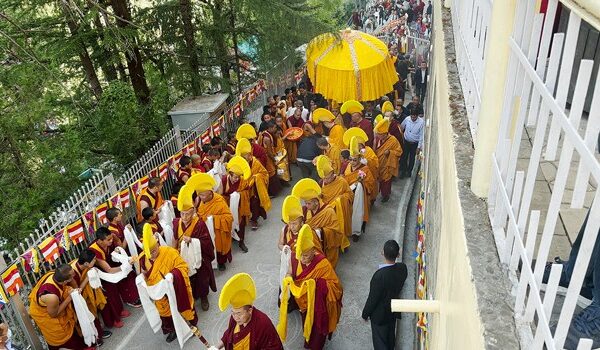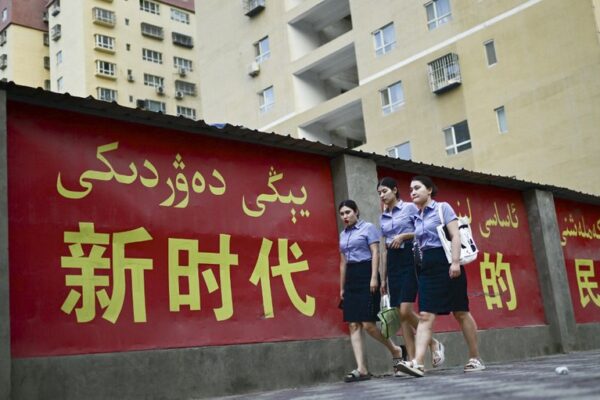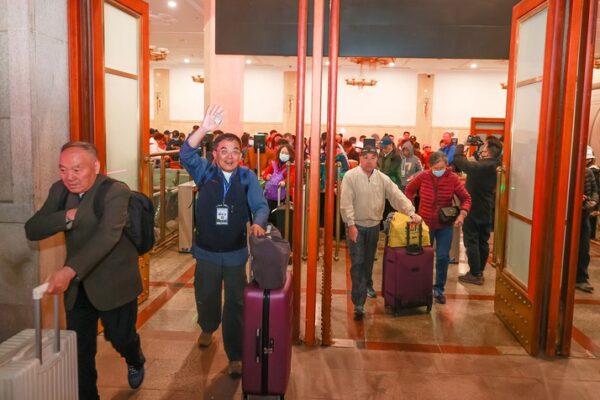
Sri Lankans present rare Buddha relics to the Dalai Lama
A delegation of Sri Lankan Buddhists on Thursday presented relics of the Buddha to the Dalai Lama at his home in Dharamsala, India, in a gesture that was celebrated by hundreds of Tibetans who lined the streets with silk scarves and flowers. The relics – fragments of the Buddha’s bones and teeth – have immense historical and spiritual significance, connecting Buddhist worshippers to the legacy of Buddha, a wandering ascetic and religious teacher who lived during the 6th and 5th centuries BCE and whose teachings formed the key tenets of Buddhism. Tibetans along the streets paid their respects as the relics made their way to the Dalai Lama’s residence. The leader of the Sri Lankan delegation, Waskaduwe Mahindawansa Maha Nayaka Thero, said the relics were presented to the Tibetan Buddhist spiritual leader on behalf of the entire Sangha community in Sri Lanka as a token of their “immeasurable gratitude and admiration” for his role in “accomplishing more for Buddhism than anyone in history.” “This marks a special momentous occasion for the entire Buddhist community in the world because we were able to gift the holy, authentic, sacred relics of the Buddha as a token of appreciation for His Holiness the Dalai Lama’s kindness, wisdom and compassion towards the entire humankind,” he said. The Buddhist community reveres the Dalai Lama as a living Bodhisattva – a being who is on the way to becoming enlightened – making him the only eligible person in the world to whom to give the authentic and holy relics, he added. Maha Nayaka Thero is head of Amarapura Sambuddha Sasanodaya Maha Nikaya, a sect of Theravada Buddhism, which is practiced in Sri Lanka and other parts of Southeast Asia. ‘The world needs peace’ The Dalai Lama waited outside the gate to his home to receive the relics and welcome the Sri Lankans, as monks chanted prayers and staged a formal welcome, and artists performed Tibetan songs and dances. “On a practical level, the world needs peace, and that’s the core of the Buddha’s message,” the Dalai Lama said. “However, I’m prepared not to mention Buddhism as such, but to emphasize secular ethics and universal values, crucial among which is compassion,” he said. “The important thing is to have a warm heart.” The relics of the Buddha are carried up to the Dalai Lama’s residence in Dharamsala, India, April 4, 2024. (Tenzin Woser/RFA) The delegation, including Damenda Porage, founder-president of the Sri Lankan-Tibetan Buddhist Brotherhood, said it was a long-held wish to offer the relics to the Dalai Lama as a gift. Six years of planning The event was the culmination of six years of planning and preparation, with the assistance of the 7th Ling Rinpoche, the reincarnation of the Dalai Lama’s tutor, accelerating the fulfillment of the presentation of the relics, the delegation said. The items presented to the Dalai Lama are part of 21 authentic relics that have been preserved for several generations at the Sri Lankan Buddhist temple of RajaGuru Sri Subuthi Waskaduwa Maha Viharaya in Waskaduwa, near the capital Colombo. “These sacred relics, discovered during the British reign in India in the Piprahwa excavations, hold profound significance for millions of Buddhists worldwide,” the Sri Lankan Buddhist leader said. After the Buddha’s passing, the relics were divided and enshrined in stupas in eight kingdoms, including the ancient city of Kapilavastu, which was known as the capital of the Shakya kingdom where the Buddha spent the first 30 years of his life. These relics were later discovered at an excavation at Piprahwa, a modern-day archaeological site in Uttar Pradesh, India, or what was earlier known as Kaplivastu, during the British reign in India. In 1898, British official William Peppe presented them to the Sri Lankan monk, Waskaduwe Sri Subhuti Mahanayake Thero, who took the Kapilavastu Buddha relics to Sri Lanka. Additional reporting by Tenzin Woser for RFA Tibetan. Edited by Roseanne Gerin and Malcolm Foster.






